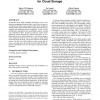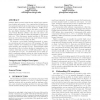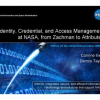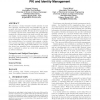CCS
2009
ACM
14 years 6 months ago
2009
ACM
Role mining algorithms address an important access control problem: configuring a role-based access control system. Given a direct assignment of users to permissions, role mining...
CCS
2009
ACM
14 years 6 months ago
2009
ACM
We introduce the concept of membership-concealing overlay networks (MCONs), which hide the real-world identities of participants. We argue that while membership concealment is ort...
CCS
2009
ACM
14 years 6 months ago
2009
ACM
The abuse of online games by automated programs, known as game bots, for gaining unfair advantages has plagued millions of participating players with escalating severity in recent...
CCS
2009
ACM
14 years 6 months ago
2009
ACM
We describe CoSP, a general framework for conducting computational soundness proofs of symbolic models and for embedding these proofs into formal calculi. CoSP considers arbitrary...
CCS
2009
ACM
14 years 6 months ago
2009
ACM
We introduce HAIL (High-Availability and Integrity Layer), a distributed cryptographic system that allows a set of servers to prove to a client that a stored file is intact and r...
CCS
2009
ACM
14 years 6 months ago
2009
ACM
Software flaws in native methods may defeat Java’s guarantees of safety and security. One common kind of flaws in native methods results from the discrepancy on how exceptions...
IDTRUST
2009
ACM
14 years 6 months ago
2009
ACM
IDTRUST
2009
ACM
14 years 6 months ago
2009
ACM
In this paper, we describe the challenges in using Personal Identity Verification (PIV) cards and PIV-like cards as federated identities to authenticate to US Federal government f...
IDTRUST
2009
ACM
14 years 6 months ago
2009
ACM
Mailing lists are a natural technology for supporting messaging in multi-party, cross-domain collaborative tasks. However, whenever sensitive information is exchanged on such list...
IDTRUST
2009
ACM
14 years 6 months ago
2009
ACM
We introduce a formal semantics based calculus of trust that explicitly represents trust and quantifies the risk associated with trust in public key infrastructure (PKI) and iden...




